Seismologists say while earthquakes are not increasing in frequency, they are becoming more deadly due to densely packed populations, poor infrastructure, and a lack of enforced earthquake-protected building codes
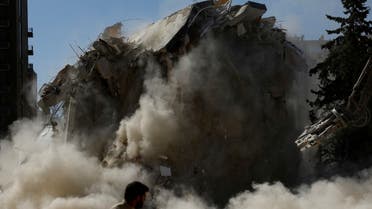
A damaged building gets knocked down in the aftermath of a deadly earthquake in Adana, Turkey, March 6, 2023. (Reuters)
Jennifer Bell, Al Arabiya English
Published: 26 January ,2024
After some of the most devastating earthquakes to decimate the region in recent years, some may fear quakes and seismic shocks are becoming a more common occurrence around the world.
Tremors have ripped apart communities across Afghanistan, Morocco, Turkey and Syria in the past 18 months.
Seismologists and geologists, however, have told Al Arabiya English that while shocks that cause such devastating damage are not increasing in frequency, they are nonetheless becoming more deadly due to densely packed populations, poor infrastructure, and a lack of earthquake-protected building codes to keep up with rampant population growth.
Turkey-Syria devastation, one year on
Almost a year has passed since the devastating and powerful earthquake that struck Turkey and Syria on February 6, 2023, claiming more than 60,000 lives and causing widespread destruction.
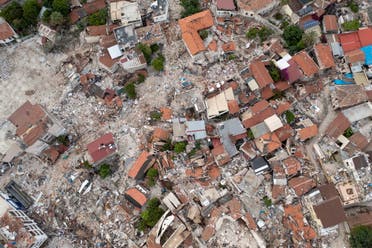
An aerial view shows Antakya's historical city center, the worst hit in an earthquake which killed more than 50,000 people in Turkey and leaving millions homeless, in Hatay province, Turkey May 5, 2023.
The 7.8-magnitude quake, followed by a second earthquake that notched up a 7.5 on the Richter Scale, was among the strongest ever recorded in the region, with hundreds of thousands more injured and scores of buildings leveled.
Other violent seismic shocks have since been reported across the Middle East and the wider world.
On September 8, 2023, a strong earthquake struck Morocco, killing more than 2,900 and leaving 5,500 injured. The 6.8 magnitude quake struck 72 kilometers southwest of Marrakech and leveled housing blocks.
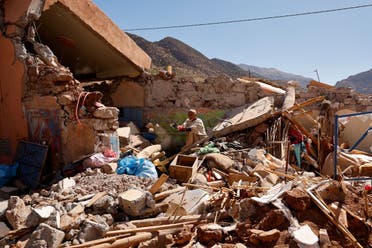
Ait Abdellah Brahim, 86, gestures among rubble, in the aftermath of a deadly earthquake, in Talat N'Yaaqoub, Morocco, September 16, 2023. (Reuters)
Afghanistan is also frequently hit by earthquakes, especially in the Hindu Kush Mountain range, near the junction of the Eurasian and Indian tectonic plates. In October 2023, around 1,000 people were killed when a series of quakes with magnitudes measuring between 4.2 and 6.3 jolted western Afghanistan.
Speaking to Al Arabiya English, Suzan van der Lee, a professor in Earth and Planetary Sciences at Northwestern University, US, said each year, worldwide, there are about a dozen earthquakes with magnitudes of at least seven on the Richter scale, ten times more of magnitudes of at least 6, 100 times more of magnitudes of at least 5, and many more minor tremors across the globe.
“If one of these occurs near dense population and infrastructure and is unanticipated, then it can have devastating consequences,” said Van der Lee, who co-developed Earthtunes. In her research, she applies data science to millions of records of seismic waves in order to decode seismic signals, which hold vital information about the Earth’s interior dynamics.
Judith Hubbard, a Harvard graduate and earthquake scientist in the US, told Al Arabiya English that hundreds of thousands of earthquakes are recorded each year, but most of them are either too small or too far away from human habitation to cause any damage.
In most years, she says, there are more than 150 earthquakes with a magnitude of 6 on the Richter Scale, 10-15 with a magnitude of more than seven and up to four magnitude 8+ earthquakes.
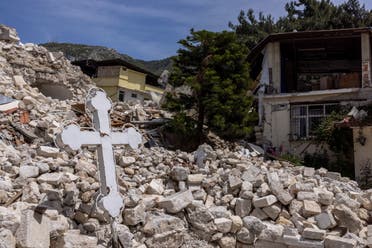
A cross is seen on the wreckage of Greek Orthodox Church at Antakya's historical city center, the worst hit in an earthquake which killed more than 50,000 people in Turkey and leaving millions homeless, in Hatay province, Turkey May 4, 2023. (Reuters)
“Whether or not these cause damage really depends on where they occur: Whether they are close to population centers, and shallow or deep.”
What causes earthquakes, and how common are they?
The majority of earthquakes occur in the vicinity of tectonic plate boundaries, where large sections of the Earth’s crust and the uppermost portion of the mantle, situated directly beneath the crust, converge.
Van der Lee says in the Middle East and Asia, several belts of heightened seismic activity are associated with the present-day Eurasian, Arabian, Somalian, and Nubian tectonic plates. Additionally, a past plate boundary that subducted the Tethys Ocean contributes to seismicity in the region.
“They are associated with present or past tectonic plate boundaries. There may only be a few of the strongest earthquakes in a certain place in a given millennium. So, compared to human lifetimes, they are not frequent,” Van der Lee reasoned.
Hubbard said the Middle East lies along a boundary between colliding tectonic plates, and the whole region is deforming as a result.
“A large number of active faults have formed to accommodate that deformation, including the Dead Sea Fault (which runs through Syria, Lebanon and Israel), the East Anatolian Fault and North Anatolian Fault in Turkey, the various faults on the Zagros Thrust Belt in Iran, and many more.”
Are more earthquakes being detected?
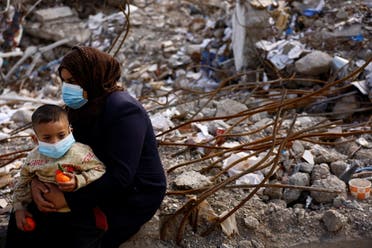
Vefa Abdullah holds her nephew Ali Sulo, 3, as they sit in the rubble of what used to be their home in the aftermath of a deadly earthquake in Kahramanmaras, Turkey, March 9, 2023.
Van der Lee said experts have only been counting earthquakes for precisely half a century, “which is very short from a geological perspective.”
“In that context, most unexpected events are the results of typical statistical fluctuations (they are the result of chance) rather than systematic global trends, Van der Lee said, adding: “However, if one happens in our lifetimes, followed by a typical sequence of aftershocks, then it sure seems like earthquakes are becoming more frequent. Of course, they are more frequent during any aftershock sequence, but on a timescale of decades, the occurrences of these earthquakes are typical.”
However, the world “should expect more” of the types of earthquakes seen in Turkey and Syria, she said.
According to Hubbard, there has not been any significant change in earthquake patterns worldwide in recent years. “Earthquake patterns are by their nature irregular, so each year we see a different set of events,” she said. “However, there are no global trends in
the fundamental tectonics. There are, however, trends in how and where people live and their exposure to earthquake hazards.”
Hubbard said this also holds for the Middle East.
“People naturally focus on recent events, but the Middle East has always suffered periodic damaging earthquakes,” she said. “The February 6, 2023, earthquakes in Turkey were terrible, but so was the 1999 Izmit earthquake (17,000 deaths) and the 1939 Erzincan earthquake (32,000 deaths), among others.”
Hubbard said the 2022 earthquake in Kabul killed more than 1,000 people. The more recent October 2023 earthquakes near Herat killed more than 2,500. The 2003 earthquake in Bam, Iran, killed 26,000.
“Some of these extremely damaging earthquakes were not even that large by global standards. Their high death tolls reflect their location (close to people) and the vulnerability of the populations living near them (buildings that are not resistant to earthquakes).”
Denser populations lead to higher death tolls
Dr. Brian Baptie, a seismologist with the British Geographical Survey, told Al Arabiya English that more reportage of such natural disasters – and news shared on social media channels – can lead to the assumption that more earthquakes are happening, though that is not the case.
“I mean, all these devastating earthquakes that occurred do definitely give you the impression that there are more earthquakes and that they didn’t happen before. However, if you actually look back at the average statistics over the last 30 or even 100 years or so, on an average, the number of earthquakes is pretty much the same, or at least the average of the number of big earthquakes a year is the same,” he reasoned.
However, while the frequency of earthquakes is not changing, the scale of their devastation is, said Baptie, because global population is increasing, with many living in densely built-up areas. That includes areas such as Turkey in the Middle East and regions in India and Pakistan.
Eduardo Kausel, professor at the Massachusetts Institute of Technology, also told Al Arabiya English that earthquakes have produced more damage in recent decades “mainly because of the explosive rise in population and the fast growth of the built environment, but measured over millennia, quakes are surely not more intense or more frequent.”
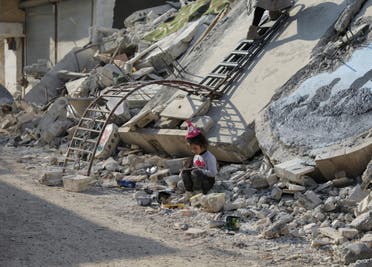
Syrian artist Salam Hamed's daughter Sima sits in the rubble of damaged buildings in the rebel-held town of Jandaris, in the aftermath of a deadly earthquake, in Syria February 22, 2023.
Kausel added: “The known, historic seismic activity in that area of the world stretches back thousands of years. Although the activity itself hasn’t increased over the centuries, its reporting has increased, given that there are many more witnesses and people affected, not to mention modern media.”
Where do earthquakes most commonly occur?
Earthquakes predominantly strike in three major zones globally. The circum-Pacific seismic belt, known as the “Ring of Fire,” encircles the Pacific Ocean, hosting 81 percent of the world’s largest earthquakes. This belt thrives along tectonic plate boundaries, where plates subduct, causing slips and ruptures. Examples include the powerful M9.5 Chilean Earthquake (1960) and the M9.2 Alaska Earthquake (1964).
The Alpide earthquake belt spans Java to Sumatra, through the Himalayas, the Mediterranean, and the Atlantic, contributing to 17 percent of major earthquakes. Notably, the 2005 M7.6 Pakistan quake claimed over 80,000 lives, and the 2004 M9.1 Indonesia earthquake triggered a tsunami that killed over 230,000.
The third significant belt aligns with the submerged mid-Atlantic Ridge, a divergent plate boundary. While mostly underwater, Iceland, directly above this Ridge, has witnessed earthquakes up to at least M6.9. Though most seismic activity occurs in these belts, damaging earthquakes can still surprise outside these regions.
Hubbard also says most earthquakes occur along plate boundaries. Some places that are particularly prone to damaging earthquakes are the west coast of the Americas, the borders of Southeast Asia, the Philippines/Taiwan/Japan, eastern Africa, and the wide zone of collision between Eurasia and Africa/Arabia/India.
“This collisional belt, in particular, is especially hazardous,” she said. “It is more than 10,000 km long, reaching from North Africa and Spain in the west to India and China in the east. Deformation occurs at shallow depth over a very broad area, in some places more than 2,000 km wide. A huge number of countries are impacted by this
system, including parts of southern Europe, North Africa, the Middle
East, and South and East Asia.”
Deadliest earthquakes in history
In recent memory, the colossal Indian Ocean earthquake on December 26, 2004, stands as a stark reminder of nature’s destructive force. Recorded as the fifth deadliest earthquake in history, its epicenter was off the west coast of Sumatra in Indonesia. Ranging from 9.1 to 9.3 in magnitude, the earthquake occurred as the Indian Plate was subducted by the Burma Plate. Following the seismic shock, a series of deadly tsunamis swept through, eradicating everything in the path of the colossal waves. Indonesia bore the brunt of the disaster, followed by Sri Lanka, India, and Thailand. The US Geological Survey reported a staggering total of 227,898 casualties.
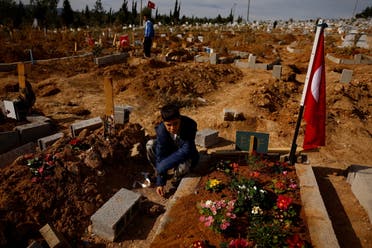
Salih Dogru, 12, and his cousin Eren Dogru, 14, visit earthquake victims' graves at Cankaya cemetery, where they moved to in the aftermath of a deadly earthquake in Iskenderun, Turkey, March 12, 2023. Last month's devastating earthquakes killed more than 54,000 people in Turkey and Syria and left millions homeless. Shortly after the first earthquake struck on Feb. 6, Salih’s uncle, undertaker Ali Dogru, 46, moved his family to the cemetery. They have been living there since (Reuters)
The Tangshan earthquake, another catastrophic event etched in history, struck Tangshan in Hebei, China, on July 28, 1976. This industrial city, home to about one million residents, faced unprecedented devastation, resulting in the loss of approximately 240,000 lives and severe injuries to an additional 164,000 people.
More recently, Hubbard said, the Turkey-Syria earthquakes were notable because of their magnitudes and the fact that there were two of them – the first a magnitude of 7.8 on the Richter Scale and the second a magnitude of 7.7 – occurring about nine hours after the first on a different Faultline, in addition to the usual aftershocks.
“Shaking intensities were very high along the faults that slipped,” she explained. “In the first earthquake, three-quarters of a million people experienced intense shaking ... we saw widespread building damage, including the collapse of a number of tall apartment complexes.”
In comparison, the 2022 earthquake in Afghanistan’s Kabul was much smaller.
“The October 2023 earthquakes in Afghanistan caused significant damage – a series of four M6.3 events over a series of about a week. The 2002 Bam earthquake in Iran was particularly damaging,” she further said.
Are climate change and human activity the factors?
Significantly, contrary to popular perception, Van der Lee says climate change is not a factor in earthquakes. “Most effects of climate or weather on seismic activity are small at best and only manifest in regions undergoing rapid melting of ice caps, for example. It is very unlikely that the seismicity in the Middle East is influenced by climate change,” she said.
However, human activities such as mining, reservoir-induced seismicity, or oil-and-gas extraction can contribute to seismic events in the Middle East, she added. “Human activities like that have induced and triggered small to moderate-magnitude earthquakes in several places around the world, so I wouldn’t be surprised if this included the Middle East.”
Hubbard also said there is no evidence linking climate change to seismic activity in the Middle East – or anywhere else – but agreed that “human activities can indeed cause earthquakes.” She pointed to reservoir-triggered seismicity, which has been observed near dams during construction, impoundment, and cyclic filling in many parts of the Earth, including Turkey.
“Occasional moderate earthquakes have been linked to reservoirs. For instance, the Atatürk Dam in Turkey has been linked to several (seismic) events,” Hubbard further said.
“It is well known that the oil-and-gas extraction process can trigger seismicity (especially the process of injecting wastewater back into the Earth). This has definitely been implicated in parts of the US.
Moreover, groundwater extraction has also been observed to be linked to earthquakes in some parts of the Middle East – for instance, along the Dead Sea Fault in Jordan at the Wadi Al-Arab basin.”
Shaking events associated with mining are regularly detected, said Hubbard.
“These are mostly detections of actual blasting and are not considered ‘earthquakes’ in the traditional sense, in that they don’t involve slip-on faults in the Earth. (In contrast, wastewater injection weakens faults, allowing them to slip.) Some forms of mining do involve injecting water into the subsurface, in which case they can
trigger earthquakes. However, thus far, the largest and most damaging earthquakes have not been linked to anthropogenic activities,” Hubbard further explained.
Monitoring earthquakes
Van de Lee said there is more that could be done to forewarn and forearm countries ahead of earthquakes.
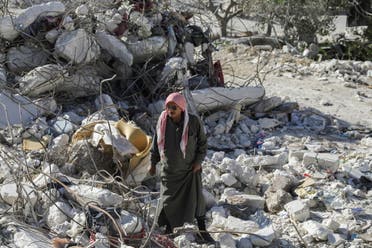
Fadel El Jaber, stands on rubble of the building his son lived with his family, that collapsed from last month's deadly earthquake in the town of Salqin, Syria March 10, 2023.
“Earthquake monitoring has improved with humanity having expanded its instrumental sensing and recording activities, as well as methodologies for analyzing seismic data,” she said.
However, to date, no one is able to predict earthquakes accurately, she added. “The best we can do is anticipate and be prepared for them.”
That, she says, means early-warning systems in place to alert the public during any seismic activity.
Van der Lee says building codes in earthquake-prone countries are also key in order for new or existing buildings to meet the structural standards to cope with seismic disturbances. These ratings are instrumental in gauging a structure’s ability to withstand tremors, providing crucial insights into potential risks.
Building codes are key
A building, or specific sections of it, earns the ominous label of “earthquake-prone” if it is projected to surpass its ultimate capacity during a moderate earthquake. The implications are dire, as such structures, if they were to collapse, pose a significant threat of causing injury or even death to individuals within or near the building. Additionally, the collateral damage extends to adjacent properties, intensifying the urgency for comprehensive seismic assessments and mitigation strategies.
“Turkey, for example, has building codes,” said Van der Lee. “These codes need to be regularly reviewed and, updated and adhered to. This can really help prevent devastation. Most risks are posed by the built environment.”
Measures to mitigate earthquake damage include incorporation of comprehensive geoscience education into the national curriculum, the establishment of local earthquake centers to enhance monitoring and research, and effective science communication to dispel misinformation.
Development of an “earthquake culture” is the central theme, encouraging a collective consciousness about earthquakes through initiatives that promote memory, awareness, and community engagement.
Baptie also said there are ways the world can mitigate the impact of earthquakes – and making sure buildings are safer is priority number one.
“We cannot predict earthquakes, but we do have a pretty good idea of where most of those earthquakes occur, so we can establish where they’re likely to occur.”
Many countries that are in areas of high earthquake hazard activity said Baptie, have building codes, and that’s true in countries like Turkey and Iran.
The crucial thing is that building codes need to be enforced. He said it was “pretty clear” in the Turkey earthquakes last year that there were a lot of modern buildings that were recently constructed, after a time when other buildings had been strengthened following the major earthquakes in Turkey in 1999.
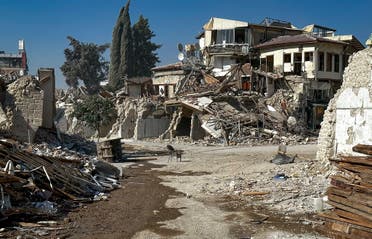
The remains of buildings destroyed during the earthquake are pictured in Antakya, southeastern Turkey Saturday, Aug. 5, 2023.
“The other things we can do is retrofit existing buildings, so we can do things to our buildings to make them stronger,” Baptie added.
The problem is that in many earthquake-sensitive areas, there are still large numbers of people living in quite vulnerable buildings.
“In places like Afghanistan, there are a lot of people who are living in just un-reinforced brick buildings. These are very, very vulnerable to earthquake shaking and that’s a major problem,” Baptie added.
Hubbard said the “only truly useful approach” to mitigating the impact of potential earthquakes is to build resilient buildings.
Effective disaster management
Another key step in minimizing the devastation from future earthquakes is by ensuring international coordination, said Van der Lee. “Every earthquake reveals new information that, after analysis and related research, helps us better understand earthquakes in general,” she said.
“Seismology has a long tradition of international collaboration that can and should be further strengthened. The power of the Earth and earthquakes surpasses humanity’s combined powers. We should, therefore, be united in learning to understand them and how to minimize the devastation that might result from some of them.”
Hubbard agrees.
“Earthquake prediction remains impossible,” she said. “Instead, we rely on earthquake forecasting (i.e. detecting zones that could be impacted by earthquakes on nearby active faults), aftershock forecasting (understanding the risk of continued events after a large earthquake), and earthquake early warning (detecting an earthquake early and sending a warning signal to nearby phones to alert people to incoming shaking, giving tens of seconds of warning time).”
Seismometer networks in the Middle East vary from country to country, said Hubbard. For instance, she says, Turkey has “excellent networks”, but some nearby countries have few seismometers.
Some countries in the Middle East are part of the EMSC (European-Mediterranean Seismological Centre) and report their data to that group – but not all, said Hubbard.
“The EMSC also operates a novel system that uses human responses to detect earthquakes, which really helps in areas where there are not so many seismometers.”
Hubbard said it was very clear following the February 2023 Turkey-Syria earthquakes that the world’s ability to “see” earthquakes was very regional.
“For instance, many people in Syria and Lebanon reported feeling aftershocks that were not detected by global seismological networks. In contrast, reports of shaking in Turkey were almost always matched to a detected event.”
International collaboration
Hubbard also stressed the importance of international collaboration to understanding earthquakes.
“Earthquakes are global phenomena. There are many cases where we know comparatively little about what happened in an earthquake because it occurred in an area without good instrumentation or a good understanding of the geology of a region. I have found that in most cases, scientists are willing to collaborate across political borders, but they are sometimes held up by regulations that prevent easy or effective collaboration,” she said.
“More work on building international links through science and hazard mitigation could strengthen existing relationships and help vulnerable communities,” Hubbard added.
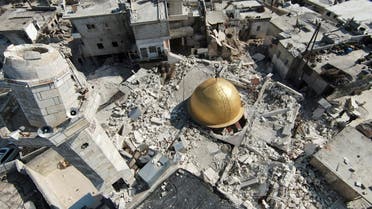
A general view shows a damaged mosque in the aftermath of a deadly earthquake, in rebel-held al-Maland village, in Idlib province, Syria February 24, 2023. (Reuters)
Can AI future-predict earthquakes?
Baptie said, going forward, the use of artificial intelligence (AI) may be an incredibly helpful tool for earth scientists and geologists in earthquake mitigation and management.
“What we are interested in now is using AI to first detect and characterize earthquakes,” he said. “There have been big advances in this over the last four or five years.”
“AI at the moment is incredibly good at finding patterns. It can detect really small earthquakes that some of our other systems can’t. So, what it means is that we can get very data-rich catalogs of information that can help us understand the hazards a little better,” Baptie added.
“The next step is probably to try and use AI knowledge systems to try and make forecasts of earthquakes and to try and make short-term forecasts about earthquakes. That is still pretty much a work in progress. But it has potential.”
So, could one day earthquakes be predicted?
“That is the holy grail,” said Baptie.
No comments:
Post a Comment